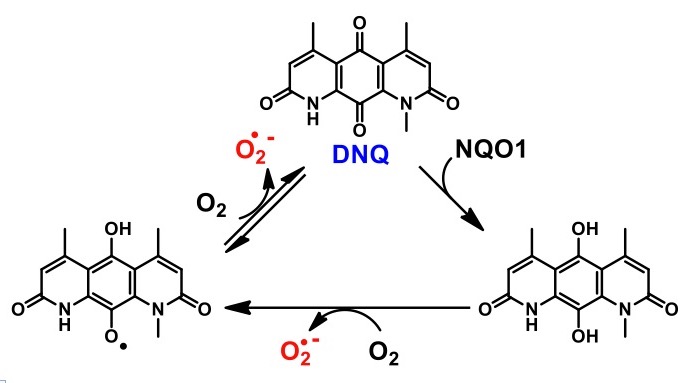The enzyme NQO1 is typically a detoxification enzyme, catalyzing the reduction and elimination of exogenous and endogenous quinones. However, in 2012 we discovered that the action of NQO1 on the compound deoxynyboquinone (DNQ) results in reduction to the hydroquinone, followed by rapid conversion back to DNQ, and generating toxic reactive oxygen species in the process. As NQO1 is not appreciable expressed in normal tissue and is highly expressed in many solid tumors, DNQ rapidly and selectively generates ROS in tumor cells, and is very potent both in cell culture and in mouse models of cancer. DNQ and its derivatives have tremendous potential as potent and personalized anticancer agents.

Related Publications:
- Augmented concentration of isopentyl-deoxynyboquinone in tumors selectively kills NAD(P)H quinone oxidoreductase 1-positive cancer cells through programmed necrotic and apoptotic mechanisms
Wang J, Su X, Jiang L, Boudreau MW, Chatkewitz LE, Kilgore JA, Zahid KR, Williams NS, Chen Y, Liu S, Hergenrother PJ, Huang X
Cancers 2023, 15, 5844
Link to Journal
- IP-DNQ induces mitochondrial dysfunction and G2/M phase cell cycle arrest to selectively kill NQO1-positive pancreatic cancer cells
Jiang L, Liu Y, Tumbath S, Boudreau MW, Chatkewitz LE, Wang J, Su X, Rafiq, Zahid K, Li K, Chen Y, Yang K, Hergenrother PJ, Huang X
Antioxid. Redox Signal. 2023, in press published on web November 11, 2023
Link to Journal
- Utilizing feline oral squamous cell carcinoma patients to develop a targeted therapy with potential for human head-and-neck cancer
Lundberg, A.P.; Boudreau, M.W.; Selting, K.A.; Chatkewitz, L.E.; Samuelson, J.; Francis, J.M.; Parkinson, E.I.; Barger, A.M.; Hergenrother, P.J.; Fan, T.F.
Neoplasia 2021, 8, 811-822
Link to journal
Article PDF
- Epigenetic loss of RNA-methyltransferase NSUN5 in glioma targets ribosomes to drive a stress adaptive translational program
Janin M.; Ortiz-Barahona V.; Boudreau M.W.; Hergenrother P.J.; Esteller M. and others
Acta Neuropathol. 2019, 138, 1053–1074
Link to journal
Article PDF
- Reactive Oxygen Species Synergize to Potently and Selectively Induce Cancer Cell Death
Lee, H.-Y.; Parkinson, E. I.; Granchi, C.; Paterni, I.; Panigrahy, D.; Seth, P.; Minutolo, F.; Hergenrother, P. J.
ACS Chem. Biol. 2017, 12, 1416-1424
Link to journal
Article PDF
- Pharmacokinetics and Derivation of an Anticancer Dosing Regimen for the Novel Anti-Cancer Agent Isobutyl-Deoxynyboquinone (IB-DNQ), a NQO1 Bioactivatable Molecule, in the Domestic Felid Species
Lundberg, A. P.; Francis, J. M.; Pajak, M.; Parkinson, E. I.; Wycislo, K. L.; Rosol, T. J.; Brown, M. E.; London, C. A.; Dirikolu, L.; Hergenrother, P. J.; Fan. T. M.
Invest New Drugs 2017, 35, 134-144
Link to journal
Article PDF
- Deoxynyboquinones as NQO1-Activated Cancer Therapeutics
Parkinson, E. I.; Hergenrother, P. J.
Acc. Chem. Res. 2015, 48, 2715-2733
Link to journal
Article PDF
- Efficient NQO1 Substrates are Potent and Selective Anticancer Agents
Parkinson, E. I.; Bair, J. S.; Cismesia, M.; Hergenrother, P. J.
ACS Chem. Biol. 2013, 8, 2173-2183.
Link to journal
Article PDF
Meet the Authors
- An NQO1 Substrate with Potent Anti-Tumor Activity that Selectively Kills by PARP-1-Induced Programmed Necrosis
Huang, X.; Dong, Y.; Bey, E. A.; Kilgore, J. A.; Bair, J. S.; Li, L.-S.; Patel, M.; Parkinson, E. I.; Wang, Y.; Williams, N. S.; Gao, J.; Hergenrother, P. J.; Boothman, D. A.
Cancer Res. 2012, 72, 3038-3047.
Link to journal
Article PDF
- Chemistry and Biology of Deoxynyboquinone, a Potent Inducer of Cancer Cell Death
Bair, J. S.; Palchaudhuri, R.; Hergenrother, P. J.
J. Am. Chem. Soc. 2010, 132, 5469-5478.
Link to journal
Article PDF